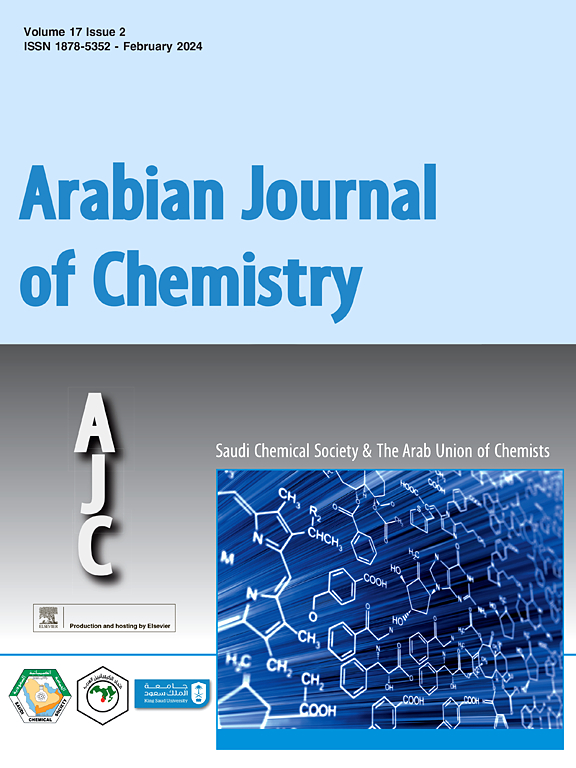Three new spirocyclic terpenoids from Euphorbia amygdaloides exhibit cytotoxicity against cancerous cell lines through early and late apoptosis
IF 5.2
2区 化学
Q2 CHEMISTRY, MULTIDISCIPLINARY
引用次数: 0
Abstract
Bioassay-guided fractionation led to the isolation of three new spirocyclic terpenoid compounds from Euphorbia amygdaloides L., named Zagrosin I–III. Their structures were identified by 1D and 2D NMR (1H NMR, 13C NMR, DEPT 135, HMBC, and HSQC-TOCSY) and LC-MS-MS spectrometry. The cytotoxicity of the isolated spirocyclic terpenoids (Zagrosin I-III) was assessed against human breast cancer (MCF-7), human fibrosarcoma (HT1080), and normal human foreskin fibroblast cells with MTT assays (24, 48, and 72 h treatments). The FITC-Annexin V apoptosis flow cytometry assays and cell cycle analysis were performed for Zagrosin I–III.
These isolated compounds were identified as: (9)-8a-((benzoyloxy)methyl)-2-methoxy-4,9-dimethyltetrahydro-4H,5H-2,4a-methanobenzo[d] [1,3] dioxine-4-carboxylate (Zagrosin I), ((9)-4-hydroxy-2-methoxy-4,9-dimethyltetrahydro-4H,8aH-2,4a-methanobenzo[d] [1,3] dioxin-8a-yl) methyl benzoate (Zagrosin II), and (9)-2-methoxy-4,9-dimethyl-8a-(phenoxy methyl) tetrahydro-4H,5H-2,4a-methanobenzo[d][1,3]dioxin-4-yl 4-methylpentanoate (Zagrosin III).
The IC50 of Zagrosin I on 48-h-treated MCF-7 was calculated as 1.5 μg/mL. Zagrosin II and III exhibited cytotoxicity on 48-h-treated MCF-7 with IC50s of 14.04 and 12.50 μg/mL, respectively. The IC50 of Zagrosin I on human fibrosarcoma (HT1080) was 115.5 μg/mL, Zagrosin III, 16.81 μg/mL (48 h treatment), and Zagrosin II, 142.7 μg/mL (72 h treatment). Zagrosin I-III exhibited significant cytotoxicity against the MCF-7 cell line and human fibrosarcoma (HT1080), with the mechanism of early and late apoptosis affecting cells mostly in G0/G1 fallowed by S and G2 phases. MCF-7 had a higher rate of phosphatidyl serine exposure on the cell membrane than two other studied cells. The cytotoxicity on normal human foreskin fibroblasts was low. Zagrosin I-III can be considered an effective chemical backbone for anticancer drug development.
Abbreviations: 2D NMR: Two-Dimensional Nuclear Magnetic Resonance Spectroscopy; API: Atmospheric Pressure Ionization; DEPT: Distortionless Enhancement by Polarization Transfer; ELISA: Enzyme-Linked Immunosorbent assay; ERK: Extracellular signal-regulated kinase; ESI: Electrospray ionization; FBS: Fetal Bovine Serum; FITC: Fluorescein isothiocyante; fr: fraction; HMBC: Heteronuclear Multiple Bond Correlation; HPLC: High-Performance Liquid Chromatography; HSQC: Heteronuclear Single Quantum Coherence; HT1080: Human fibrosarcoma cell line; IC50: Half-maximal inhibitory concentration; MCF-7: Human breast cancer cell line; MHz: Megahertz; MTT: 3-[4,5-dimethylthiazol-2-yl]-2,5 diphenyl tetrazolium bromide; NMR: Nuclear Magnetic Resonance; PBS: Phosphate Buffered Saline; PI: Propidium Iodide; ppm: Part Per Million; Rf: Retention Factor; TLC: Thin-layer chromatography; TOCSY: Total Correlation Spectroscopy; VLC: Vacuum Liquid Chromatography.
来自大戟科植物 amygdaloides 的三种新螺环萜类化合物通过早期和晚期细胞凋亡对癌细胞株具有细胞毒性
通过生物测定指导下的分馏,从大戟科植物大戟(Euphorbia amygdaloides L.)中分离出了三种新的螺环萜类化合物,命名为大戟萜 I-III。通过一维和二维核磁共振(1H NMR、13C NMR、DEPT 135、HMBC 和 HSQC-TOCSY)以及 LC-MS-MS 光谱分析确定了它们的结构。通过 MTT 试验(24、48 和 72 小时处理)评估了分离出的螺环萜类化合物(Zagrosin I-III)对人乳腺癌(MCF-7)、人纤维肉瘤(HT1080)和正常人包皮成纤维细胞的细胞毒性。对 Zagrosin I-III 进行了 FITC-Annexin V 细胞凋亡流式细胞仪检测和细胞周期分析:(9)-8a-((benzoyloxy)methyl)-2-methoxy-4,9-dimethyltetrahydro-4H,5H-2,4a-methanobenzo[d] [1,3] dioxine-4-carboxylate (Zagrosin I)、((9)-4-hydroxy-2-methoxy-4,9-dimethyltetrahydro-4H,8aH-2、4a-甲基苯并[d][1,3]二噁英-8a-基)甲基苯甲酸酯(Zagrosin II),以及 (9)-2-甲氧基-4,9-二甲基-8a-(苯氧基甲基)四氢-4H,5H-2,4a-甲基苯并[d][1,3]二噁英-4-基 4-甲基戊酸酯(Zagrosin III)。经计算,Zagrosin I 对经 48 小时处理的 MCF-7 的 IC50 值为 1.5 μg/mL。Zagrosin II 和 III 对 48 小时处理的 MCF-7 具有细胞毒性,IC50 分别为 14.04 和 12.50 μg/mL。Zagrosin I 对人纤维肉瘤(HT1080)的 IC50 为 115.5 μg/mL,Zagrosin III 为 16.81 μg/mL(处理 48 小时),Zagrosin II 为 142.7 μg/mL(处理 72 小时)。Zagrosin I-III 对 MCF-7 细胞系和人纤维肉瘤(HT1080)具有显著的细胞毒性,其早期和晚期凋亡机制主要影响 G0/G1 期的细胞,然后是 S 期和 G2 期的细胞。与其他两种研究细胞相比,MCF-7 细胞膜上的磷脂酰丝氨酸暴露率更高。对正常人包皮成纤维细胞的细胞毒性较低。扎格罗素 I-III 可被视为开发抗癌药物的有效化学骨架:缩写:2D NMR:二维核磁共振波谱;API:常压电离:大气压电离;DEPT:ELISA:酶联免疫吸附试验;ERK:细胞外信号调节激酶;ESI:电喷雾离子化;FBS:胎牛血清;FITC:异硫氰酸荧光素;fr:馏分;HMBC:异核多键相关性:HPLC:高效液相色谱法;HSQC:异核单量子共振:HT1080:人纤维肉瘤细胞系;IC50:半最大抑制浓度;MCF-7:人乳腺癌细胞系;MHz:MTT:3-[4,5-二甲基噻唑-2-基]-2,5-二苯基溴化四氮唑;NMR:核磁共振;PBS:磷酸盐缓冲盐水:磷酸盐缓冲盐水;PI:碘化丙啶;ppm:Rf:TLC:薄层色谱法;TOCSY:总相关光谱法;VLC:真空液相色谱法:真空液相色谱法。
本文章由计算机程序翻译,如有差异,请以英文原文为准。
求助全文
约1分钟内获得全文
求助全文
来源期刊

Arabian Journal of Chemistry
CHEMISTRY, MULTIDISCIPLINARY-
CiteScore
10.80
自引率
3.30%
发文量
763
审稿时长
63 days
期刊介绍:
The Arabian Journal of Chemistry is an English language, peer-reviewed scholarly publication in the area of chemistry. The Arabian Journal of Chemistry publishes original papers, reviews and short reports on, but not limited to: inorganic, physical, organic, analytical and biochemistry.
The Arabian Journal of Chemistry is issued by the Arab Union of Chemists and is published by King Saud University together with the Saudi Chemical Society in collaboration with Elsevier and is edited by an international group of eminent researchers.
 求助内容:
求助内容: 应助结果提醒方式:
应助结果提醒方式:


